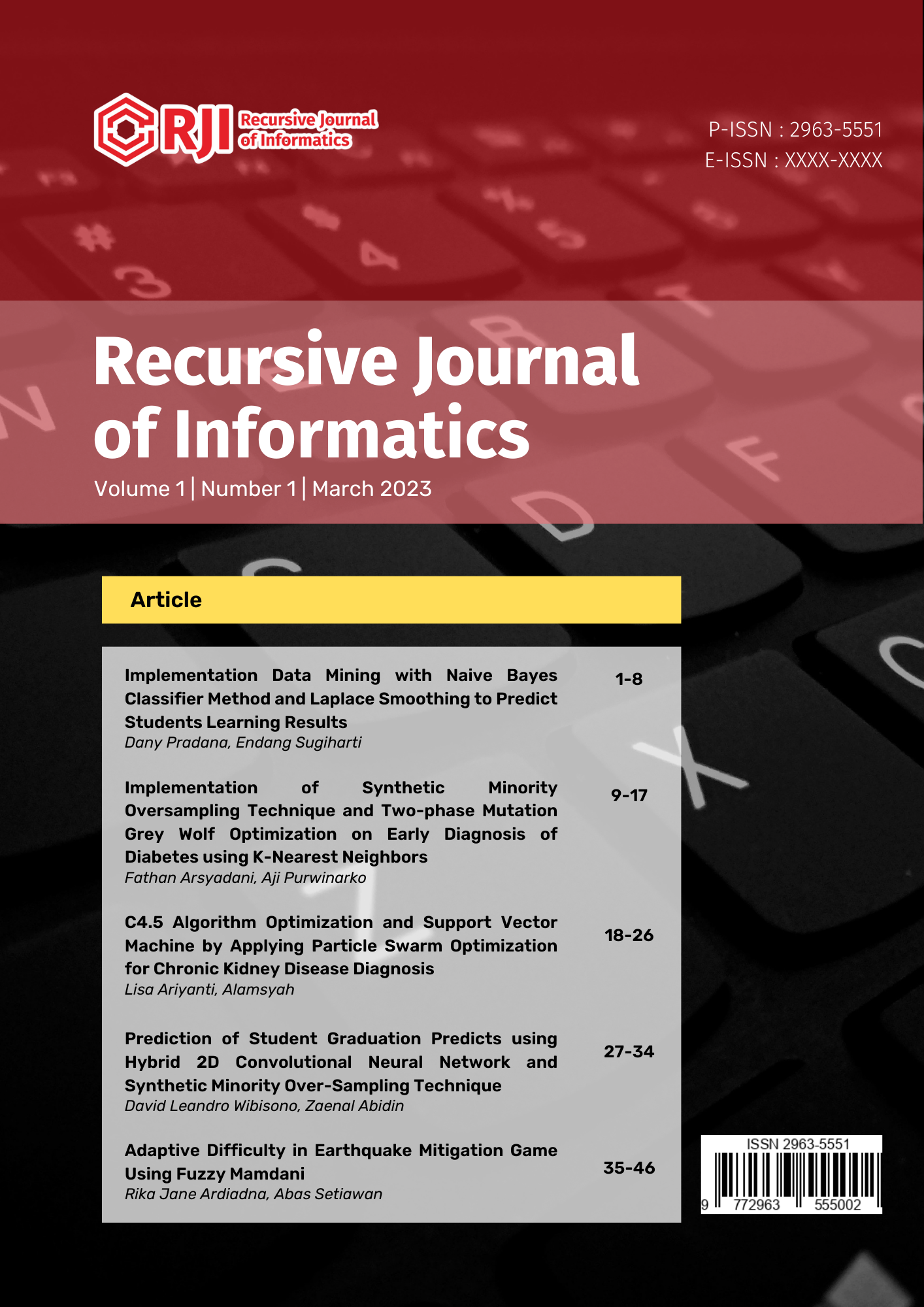C4.5 Algorithm Optimization and Support Vector Machine by Applying Particle Swarm Optimization for Chronic Kidney Disease Diagnosis
Abstract
Kidneys are one of the organs of the body that have a very important function in life. The main function of the kidneys is to excrete metabolic waste products. Chronic kidney disease is a result of the gradual loss of kidney function. Chronic kidney disease occurs when the kidneys are unable to maintain an internal environment consistent with life and the restoration of useless functions. Data mining is one of the fastest growing technologies in biomedical science and research. In the field of medicine, data mining can improve hospital information management and telemedicine development. In the first stage of data mining process, data processing is done with pre-processing by handling missing values and data transformation. Then, the feature selection stage is carried out using the Particle Swarm Optimization algorithm to find the best attributes. Next, it is done by classifying the dataset. The algorithm used for classification is the C4.5 Algorithm and the Support Vector Machine. Both classifications are known as algorithms that have a fairly good level of accuracy. This study uses the chronic kidney disease dataset from the UCI Machine Learning Repository. The purpose of this study was to determine the level of accuracy of the comparison between the C4.5 Algorithm and the Support Vector Machine after applying the Particle Swarm Optimization algorithm. This research increases the accuracy by 100% for the C4.5 Algorithm and 98.75% for the Support Vector Machine by using 24 attributes and 1 class attribute.
References
[2] A. Lestari, “Increasing accuracy of C4. 5 algorithm using information gain ratio and adaboost for classification of chronic kidney disease,” Journal of Soft Computing Exploration, vol. 1, no. 1, pp. 32–38, 2020.
[3] S. Joshi and H. Joshi, “Applications of Data Mining in health and pharmaceutical industry,” Int J Sci Eng Res, vol. 4, no. 4, 2013.
[4] J. A. M. Nugraha and Y. Kusumawati, “Data Mining dengan Metode Clustering untuk Pengolahan Informasi Persediaan Obat pada Puskesmas Pandanaran Semarang. Universitas Dian Nuswantoro,” Universitas Dian Nuswantoro, 2014.
[5] A. Alamsyah and T. Fadila, “Increased accuracy of prediction hepatitis disease using the application of principal component analysis on a support vector machine,” J Phys Conf Ser, vol. 1968, no. 1, p. 012016, Jul. 2021, doi: 10.1088/1742-6596/1968/1/012016.
[6] R. Rianto and N. M. S. Iswari, “Rancang bangun aplikasi pendeteksi penyakit ginjal kronis dengan menggunakan algoritma c4. 5,” Ultimatics: Jurnal Teknik Informatika, vol. 9, no. 1, pp. 10–18, 2017.
[7] Oryza Habibie Rahman, Gunawan Abdillah, and Agus Komarudin, “Klasifikasi Ujaran Kebencian pada Media Sosial Twitter Menggunakan Support Vector Machine,” Jurnal RESTI (Rekayasa Sistem dan Teknologi Informasi), vol. 5, no. 1, pp. 17–23, Feb. 2021, doi: 10.29207/resti.v5i1.2700.
[8] U. I. Larasati, M. A. Muslim, R. Arifudin, and A. Alamsyah, “Improve the Accuracy of Support Vector Machine Using Chi Square Statistic and Term Frequency Inverse Document Frequency on Movie Review Sentiment Analysis,” Scientific Journal of Informatics, vol. 6, no. 1, pp. 138–149, May 2019, doi: 10.15294/sji.v6i1.14244.
[9] Y. Irawan, “Penerapan Algoritma Decision Tree C4.5 Untuk Memprediksi Kelayakan Calon Pendonor Melakukan Donor Darah Dengan Klasifikasi Data Mining,” JTIM : Jurnal Teknologi Informasi dan Multimedia, vol. 2, no. 4, pp. 181–189, Feb. 2021, doi: 10.35746/jtim.v2i4.75.
[10] A. Rudianto, “Penerapan Data Mining Untuk Menganalisa Data Penjualan Pada Toko Bangunan Restu Bunda Menggunakan Metode Apriori,” 2019.
[11] Z. Rustam, M. A. Syarifah, and T. Siswantining, “Recursive Particle Swarm Optimization (RPSO) schemed Support Vector Machine (SVM) Implementation for Microarray Data Analysis on Chronic Kidney Disease (CKD),” IOP Conf Ser Mater Sci Eng, vol. 546, no. 5, p. 052077, Jun. 2019, doi: 10.1088/1757-899X/546/5/052077.
[12] E. Supriyadi and D. I. Sensuse, “Optimasi Algoritma Support Vector Machine Dengan Particle Swarm Optimization dalam Mendeteksi Ketepatan Waktu Kelulusan Mahasiswa : Studi Kasus Poltek LP3I Jakarta ‘Kampus Depok,” 2015. [Online]. Available: http://www.nusamandiri.ac.id,
[13] R. S. Putra, E. D. Putra, M. H. Rifqo, and H. Witriyono, “Klasifikasi Penyebaran Covid-19 Menggunakan Algoritma C4. 5 Kota Pagar Alam,” JUKOMIKA (Jurnal Ilmu Komput. dan Inform., vol. 4, no. 1, pp. 23–35, 2021, doi: 10.54650/jukomika. v4i1. 346, 2021.
[14] M. Hairul Umam, V. Wahanggara, T. A. Cahyanto, and L. A. Muharom, “Analisis Perbandingan Algoritma C4. 5 Dan Algoritma Naïve Bayes Untuk Prediksi Kelulusan Mahasiswa (Studi Kasus?: Prodi Teknik Informatika Universitas Muhammadiyah Jember),” Jurusan Teknik Informatika Fakultas Teknik Universitas Muhammadiyah Jember, vol. 1310651100, pp. 1–9, 2017.
[15] F. Fatmawati and M. Affandes, “Klasifikasi Keluhan Menggunakan Metode Support Vector Machine (SVM) Pada Akun Facebook Group iRaise Helpdesk,” Jurnal CoreIT: Jurnal Hasil Penelitian Ilmu Komputer dan Teknologi Informasi, vol. 3, no. 1, p. 24, Jan. 2018, doi: 10.24014/coreit.v3i1.3552.









